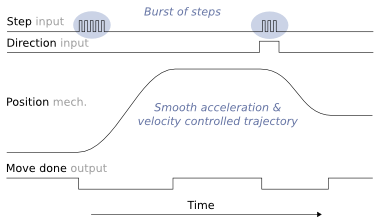Difference between revisions of "Pulse burst positioning"
From Granite Devices Knowledge Wiki
(Created page with "step & direction signals, motor position and move done output as function of time.]] Pulse bu...") |
(No difference)
|
Revision as of 02:50, 12 December 2013

Illustration of input step & direction signals, motor position and move done output as function of time.
Pulse burst positioning means a setpoint signaling based on pulse and direction format. In burst mode, controller need only to generate a burst of pulses with direction signal to drive to begin a motion relative to current position complying with pre-configured acceleration and velocity limits.
- Pulse burst positioning properties
- Simplicity - easy to understand and implement point-to-point motion control
- Exact - setpoint signal path is fully digital
- No real-time controller needed - smooth trajectory is generated inside the drive
Contents
How to use
Pulse burst is the minimalistic yet high performing position setpoint method available. Suitable signal may be generated by various means:
- PLC
- A simple timer & counter circuit
- Microcontroller GPIO pin
- Or any programmable device with controllable digital outputs
Practical example
Drive parameterization
In Argon the following configuration enables burst pulse mode:
- Set CM as Position control
- Set CRI as Pulse train & direction
- Set CAL and CVL to your desired acceleration and velocity values
- Wire J5 connector according to this diagram
Doing incremental move
The C-style code below represents the signaling.
void IncrementalMove( int distance )
{
int i;
/* set direction output pin */
if(distance<0)
SetDirectionOutputPin(0);
else
SetDirectionOutputPin(1);
/* send step pulses to start motion */
for( i=0; i< abs(distance); i++ )
{
Delay_ms(0.001);
SetPulseOutputPin(1);
Delay_ms(0.001);
SetPulseOutputPin(0);
}
}
- SetPulseOutputPin sets the digital state of HSIN1 pin on Argon
- SetDirectionOutputPin sets the digital state of HSIN2 pin on Argon
Monitoring when motion is complete
bool WaitForMoveDone( double timeout )
{
double waited=0;
while(waited<timeout)
{
if( GetMotionCompletePinState() == true )
return true; /* motion is now complete, return true*/
/*motion is not complete, wait some time and poll again*/
Delay_ms(0.01);
waited=waited+0.01;
}
/*return false because timeouted */
return false;
}
- GetMotionCompletePinState reads the GPO1 pin state from Argon
Usage example
IncrementalMove(500); WaitForMoveDone(); IncrementalMove(1000); WaitForMoveDone(); IncrementalMove(-1500); WaitForMoveDone();